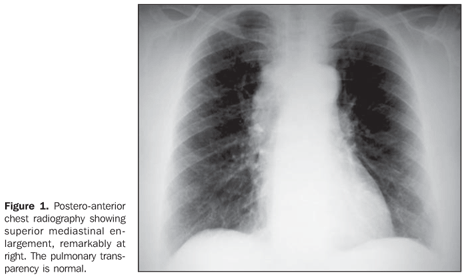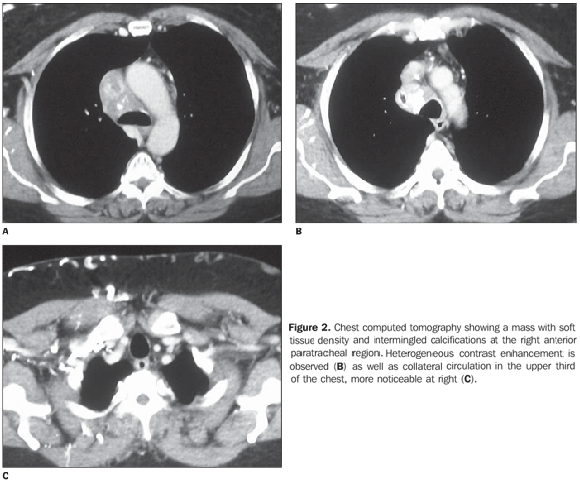Radiologia Brasileira - Publicação Científica Oficial do Colégio Brasileiro de Radiologia
AMB - Associação Médica Brasileira CNA - Comissão Nacional de Acreditação
 Vol. 42 nº 5 - Sep. / Oct. of 2009
Vol. 42 nº 5 - Sep. / Oct. of 2009
|
CASE REPORT
|
|
Fibrosing mediastinitis: a case report |
|
|
Autho(rs): Thales de Carvalho Lima, Edson Marchiori, Domenico Capone, Miriam Menna Barreto, Rosana Souza Rodrigues, Gláucia Zanetti |
|
|
Keywords: Fibrosing mediastinitis, Mediastinal mass, Fibrosis, Chest radiology |
|
|
Abstract:
INTRODUCTION Fibrosing mediastinitis, also known as sclerosing mediastinitis, is an uncommon condition characterized by proliferation of dense fibrous tissue in the mediastinum. In spite of its benignity, it is associated to a significant morbidity due to its fibrotic obstructive nature, and less commonly, to mortality(1). Its pathogenesis is unknown in most cases, also being possibly related to histoplasmosis, tuberculosis, and other granulomatous diseases, such as sarcoidosis, autoimmune and fungal diseases, radiotherapy and other fibro-inflammatory processes, for example, retroperitoneal fibrosis(2–4). Affected patients are typically young and present signs and symptoms related to obstruction of vital mediastinal structures, such as large vessels, esophagus and airways(5).
CASE REPORT A 51-year-old female patient presenting a history of chest pain, dyspnea on exertion over the last four months, and finally, vascular engorgement on the chest wall and neck. There was no epidemiological history of histoplasmosis or tuberculosis; even so, three induced sputum tests were performed, all of them negative for tuberculosis or fungi, besides serology of histoplasmosis, which was also negative. Clinical and laboratory investigations for other less frequent causes of the disease were also negative. Chest radiography demonstrated superior mediastinal enlargement, notably to the right, with no other noticeable finding (Figure 1). Chest computed tomography demonstrated a mass with soft tissue density and intermingled calcifications at the anterior right paratracheal region, with heterogeneous contrast enhancement, without cleavage plane with the superior vena cava, extending to the carina, besides the presence of collateral circulation in the chest (Figure 2).
Finally, a mediastinoscopy was performed, with a biopsy of the mediastinal mass, whose histopathological study demonstrated a chronic inflammatory fibrotic-necrotic chronic process, negative for microorganisms at silver, PAS and Ziehl-Nielsen stain. The findings were compatible with the fibrosing mediastinitis hypothesis. The patient progressed satisfactorily, with stabilization of clinical signs, and undergoing clinical follow-up.
DISCUSSION Fibrosing mediastinitis is caused by an extensive, infiltrating, and frequently invasive mediastinal fibrotic process. The inflammatory process usually sets in the upper half of the mediastinum, in the paratracheal region. It is commonly located to the right, anteriorly to the trachea and close to the pulmonary hilum; however it may also develop as a diffuse fibrosis in the mediastinum, extending from the brachiocephalic veins to the pulmonary bases(1,6). The symptoms are generally caused by obstruction of the superior vena cava, esophagus, trachea, bronchi or pulmonary veins, also causing pulmonary arterial hypertension by direct compression of pulmonary arteries, or secondary to pulmonary venous compression(4,7). Chest radiography is nonspecific, demonstrating superior mediastinal enlargement by a paratracheal lobular mass(8). Calcifications occur in most cases, requiring a computed tomography scan to characterize them and ruling out other causes of mediastinal involvement such as metastases, lymphomas and other tumors(1,9). Secondary lung alterations such as atelectasis, nodules, consolidation and interstitial infiltration are also observed(6,9). Magnetic resonance imaging is useful in the determination of the disease extent and in the preoperative planning, usually showing an image with intermediate signal intensity on T1-weighted sequences and heterogeneous signal intensity on T2-weighted sequences because of the fibrotic nature of the disease and presence of calcifications, sometimes presenting heterogeneous gadolinium enhancement(1,6,10). The course of the disease is variable, sometimes with spontaneous remission, and other times with symptoms exacerbation. Approximately 30% of patients die from complications resulting from obstruction and fibrosis. The worst prognosis is related to bilateral or carinal involvement(4,6). The definite diagnosis is obtained by means of biopsy of the affected lymph nodes or mediastinal tissue(6). The therapy includes the use of corticosteroids, surgical approach for excision of tissue and local management of obstructive complications such as the case with the use of stents(11). Finally, in spite of its uncommon character, fibrosing mediastinitis should be considered in cases of mediastinal enlargement at chest radiography, primarily for being related to granulomatous diseases such as tuberculosis that is endemic in Brazil and also for its significant morbidity, as the affected patients are typically young. The investigation must include contrast-enhanced computed tomography of chest associated with serology of tuberculosis and histoplasmosis. Biopsy with histopathological study confirms the diagnosis. Regular clinical follow-up must be performed with these patients for monitoring of possible complications resulting from the disease.
REFERENCES 1. Devaraj A, Griffin N, Nicholson AG, et al. Computed tomography findings in fibrosing mediastinitis. Clin Radiol. 2007;62:781–6. [ ] 2. Lee JY, Kim Y, Lee KS, et al. Tuberculous fibrosing mediastinitis: radiologic findings. AJR Am J Roentgenol. 1996;167:1598–9. [ ] 3. Loyd JE, Tillman BF, Atkinson JB, et al. Mediastinal fibrosis complicating histoplasmosis. Medicine (Baltimore). 1988;67:295–310. [ ] 4. Dechambre S, Dorzee J, Fastrez J, et al. Bronchial stenosis and sclerosing mediastinitis: an uncommon complication of external thoracic radiotherapy. Eur Respir J. 1998;11:1188–90. [ ] 5. Kalweit G, Huwer H, Straub U, et al. Mediastinal compression syndromes due to idiopathic fibrosing mediastinitis – report of three cases and review of the literature. Thorac Cardiovasc Surg. 1996;44:105–9. [ ] 6. Rossi SE, McAdams HP, Rosado-de-Christenson ML, et al. Fibrosing mediastinitis. Radiographics. 2001;21:737–57. [ ] 7. Mathisen DJ, Grillo HC. Clinical manifestation of mediastinal fibrosis and histoplasmosis. Ann Thorac Surg. 1992;54:1053–8. [ ] 8. Sherrick AD, Brown LR, Harms GF, et al. The radiographic findings of fibrosing mediastinitis. Chest. 1994;106:484–9. [ ] 9. Weinstein JB, Aronberg DJ, Sagel SS. CT of fibrosing mediastinitis: findings and their utility. AJR Am J Roentgenol. 1983;141:247–51. [ ] 10. Erasmus JJ, McAdams HP, Donnelly LF, et al. MR imaging of mediastinal masses. Magn Reson Imaging Clin N Am. 2000;8:59–89. [ ] 11. Kandzari DE, Warner JJ, O'Laughlin MP, et al. Percutaneous stenting of right pulmonary artery stenosis in fibrosing mediastinitis. Catheter Cardiovasc Interv. 2000;49:321–4. [ ] Received May 15, 2008. Accepted after revision June 9, 2008. * Study developed at Hospital Universitário Clementino Fraga Filho (HUCFF) – Universidade Federal do Rio de Janeiro (UFRJ), Rio de Janeiro, RJ, Brazil. |
|
Av. Paulista, 37 - 7° andar - Conj. 71 - CEP 01311-902 - São Paulo - SP - Brazil - Phone: (11) 3372-4544 - Fax: (11) 3372-4554


